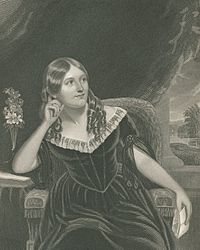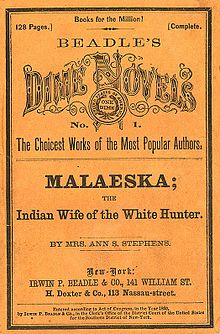| Ann Sophia Stephens | |
|---|---|
 Stephens, circa 1844 Stephens, circa 1844 | |
| Born | March 30, 1810 |
| Died | August 20, 1886 (aged 76) Newport, Rhode Island |
| Nationality | American |
| Other names | Jonathan Slick |
| Occupations |
|
Ann Sophia Stephens (March 10, 1810 – August 20, 1886) was an American novelist and magazine editor. She was the author of dime novels and is credited as the progenitor of that genre.
Early life
Ann Sophia Stephens was born on March 30, 1810, in Derby, Connecticut; she was the daughter of Ann and John Winterbotham, son of William Winterbotham. He was the manager of a woolen mill owned by Col. David Humphreys. Her mother died early and she was brought up by her mother's sister, who eventually became her stepmother. She was educated at a dame school in South Britain, Connecticut, and started writing at an early age. She married Edward Stephens, a printer from Plymouth, Massachusetts, in 1831 and they relocated to Portland, Maine. The actress Clara Bloodgood was the daughter of their son, Edward Stephens, a well known New York lawyer.
Career

While in Portland, she and her husband co-founded, published and edited the Portland Magazine, a monthly literary periodical where some of her early work first appeared. The magazine was sold in 1837. They moved to New York where Ann took the job of editor to The Ladies Companion and where she could further her literary work. This was also the time she adopted the humorous pseudonym Jonathan Slick. Over the next few years she wrote more than twenty-five serial novels plus short stories and poems for several well known periodicals which included Godey's Lady's Book and Graham's Magazine. Her first novel Fashion and Famine was published in 1854. She started her own magazine Mrs Stephens' Illustrated New Monthly in 1856, it was published by her husband. The magazine merged with Peterson's Magazine a few years later.
The term "dime novel" originated with Stephens's Malaeska, the Indian Wife of the White Hunter, printed in the first book in Beadle & Adams's Beadle’s Dime Novels series, dated June 9, 1860. The novel was a reprint of Stephens's earlier serial that appeared in the Ladies' Companion magazine in February, March, and April 1839. Later, the Grolier Club listed Malaeska as the most influential book of 1860. Some of her other work includes High Life in New York (1843), Alice Copley: A Tale of Queen Mary's Time (1844), The Diamond Necklace and Other Tale (1846), The Old Homestead (1855), The Rejected Wife (1863) and A Noble Woman (1871).
Works
- Alice Copley: A Tale of Queen Mary's Time
- A Noble Woman
- Bellehood and Bondage
- Bertha's Engagement
- The Curse of Gold, 1869
- The Diamond Necklace and Other Tale
- The Deserted Wife
- Doubly False
- Fashion and Famine 1854
- The Gold Brick, 1866
- The Gulf Between Them
- The Heiress of Greenhurst: An autobiography, 1857
- High Life in New York, 1873
- Katharine Allen; or, The Gold Brick
- The Ladies' Complete Guide to Crochet, Fancy Knitting, and Needlework, 1854
- Lord Hope's Choice
- Mabel's Mistake, 1868
- Malaeska, the Indian Wife of the White Hunter, 1860
- Married in Haste
- Mary Derwent: A Tale of Wyoming and Mohawk Valleys, 1858
- Myra: The Child of Adoption, 1860
- A Noble Woman, 1871
- Norston's Rest, 1877
- The Old Countess, 1873
- The Old Homestead, 1855
- Palaces and Prisons
- Phemie Frost's Experiences, 1874
- Pictorial History of the War for the Union, vol.1 1863, vol.2 1866
- The Portland Sketch Book, 1836
- The Reigning Belle, 1885
- The Rejected Wife
- Ruby Gray's Strategy
- Silent Struggles, 1865
- The Soldiers' Orphans
- Sybil Chase; or, The Valley Ranche, 1861
- The Wife's Secret
- Wives and Widows, 1869
- The Lady Mary
References
- ^ McHenry, Robert, ed. (1980), Famous American Women: A Biographical Dictionary from Colonial Times to the Present (2nd ed.), Courier Dover Publications, p. 392, ISBN 0486245233.
- Linkon, Sherry Lee (1997). In her own voice: nineteenth-century American women essayists. Taylor & Francis. p. 114. ISBN 0-8153-2652-1.
- ^ The National cyclopaedia of American biography. J. T. White company. 1900. p. 20.
- "Portraits of American Women Writers". Ann S. Stephens. Retrieved September 21, 2009.
- Edward Stephens (obituary) New York Times October 2, 1913, p. 11.
- Tebbel, John. A History of Book Publishing in the United States – Volume I: The Creation of an Industry (1630-1865). New York City: R.R. Bowker Co., 1972. p. 248.
- James, Edward; Janet Wison James; Paul S. Boyer (1971). Notable American women, 1607–1950. Harvard University Press. pp. 360–362. ISBN 0-674-62734-2.
Ann Sophia Stephens died 1886.
- Nelson, Randy F. The Almanac of American Letters. Los Altos, California: William Kaufmann, Inc., 1981: 201. ISBN 0-86576-008-X.
External links
- Works by Ann S. Stephens at Nickels and Dimes from Northern Illinois University
- Works by Ann Sophia Stephens at Project Gutenberg
- Works by or about Ann S. Stephens at the Internet Archive
- "Ann S. Stephens". Find a Grave. Retrieved August 9, 2010.
- Works by Ann S. Stephens at LibriVox (public domain audiobooks)
